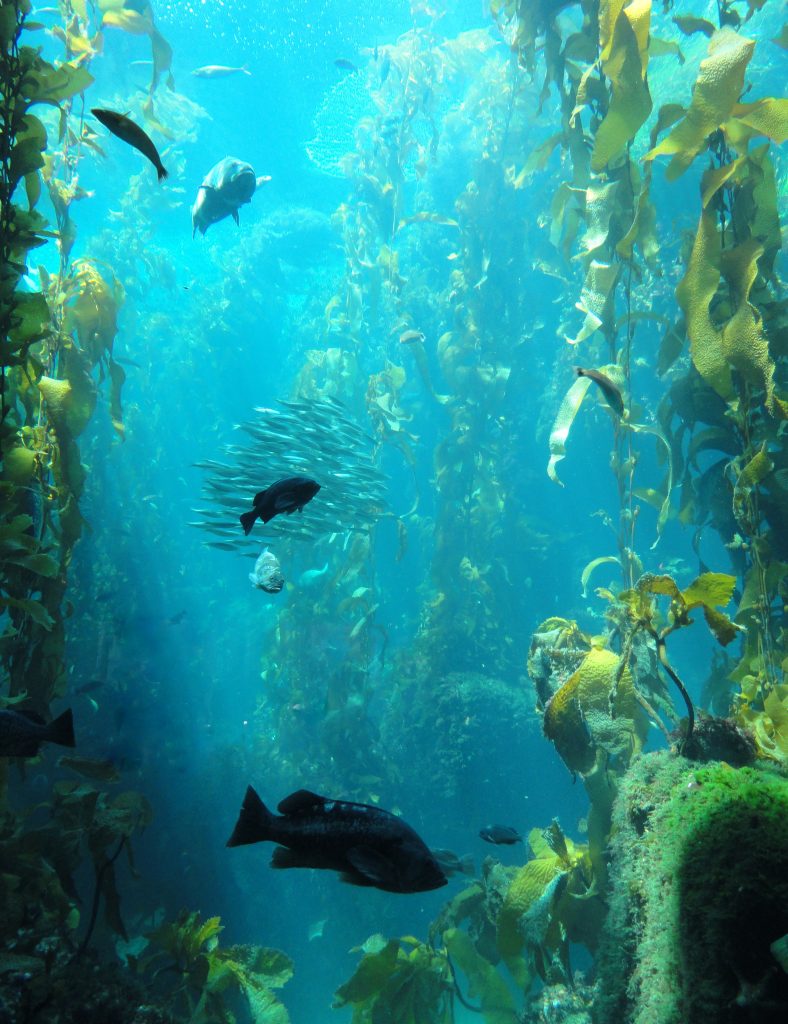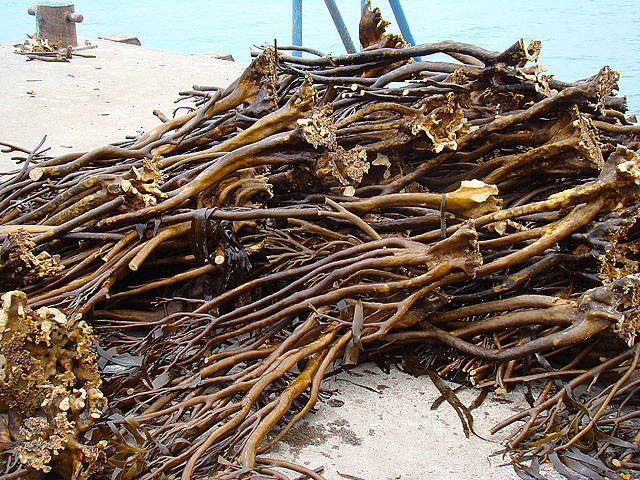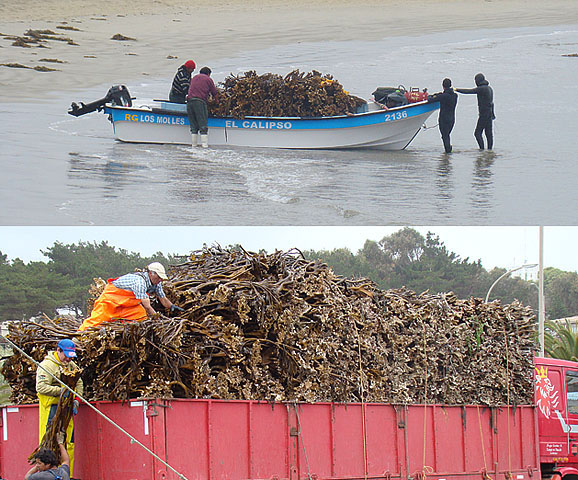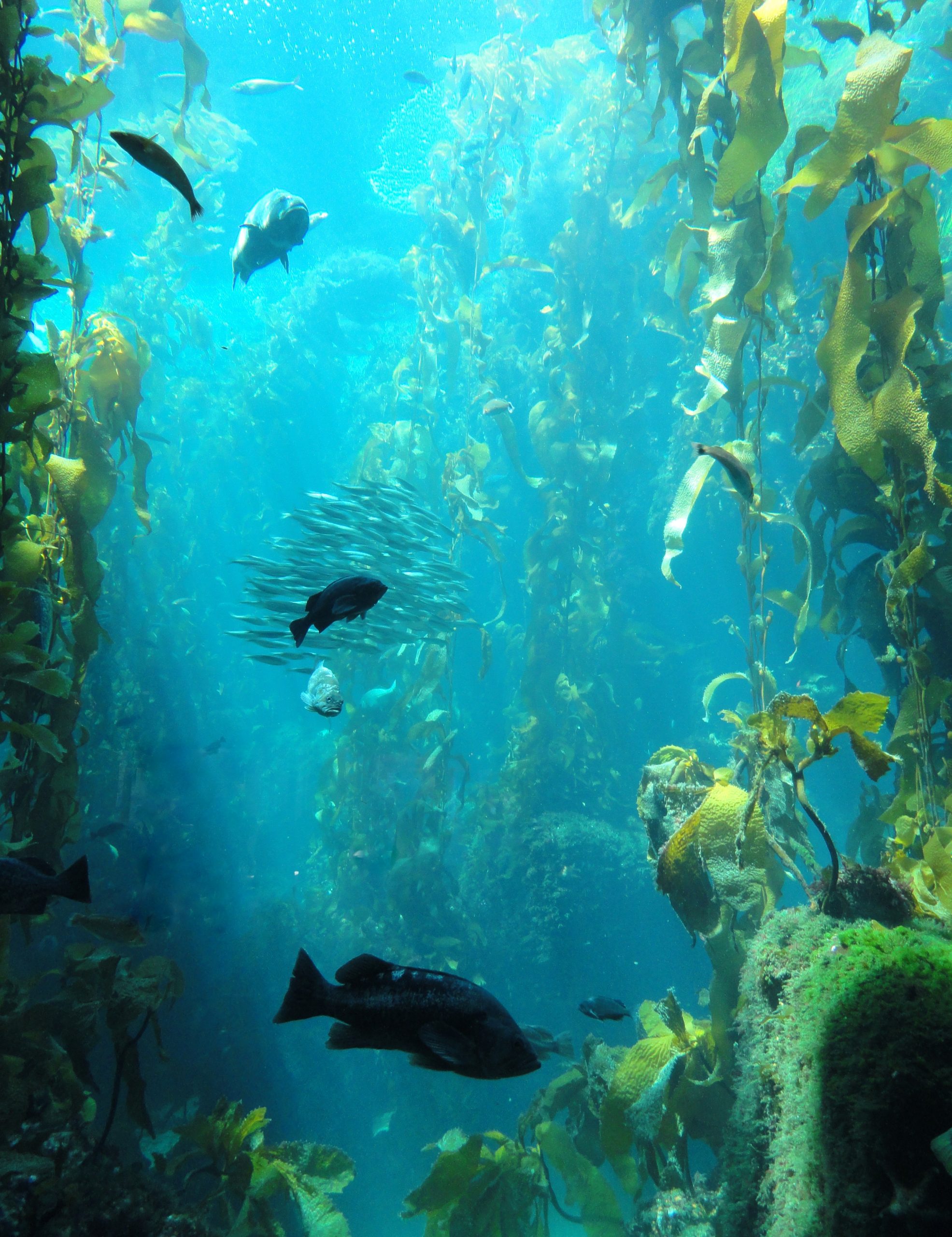Gouraguine, A., Moore, P., Burrows, M.T., Velasco, E., Ariz, L., Figueroa-Fabrega, L., Munoz-Cordovez, R., Fernandez-Cisternas, I., Smale, D., & Perez-Matus, A. (2021) The intensity of kelp harvesting shapes the population structure of the foundation species Lessonia trabeculata along the Chilean coastline. Marine Biology 168: 66. Doi: 10.1007/s00227-021-03870-7
Kelp Forests- Important for the Ocean and Humans
Imagine you’re taking a walk along the beach. The sun is shining, there’s a cool breeze, and everything seems perfect, except for the piles of seaweed you keep stepping in! While you might think of seaweed and kelp as a nuisance, in many communities around the world this type of marine algae is both commercially valuable and important for coastal ecosystems.
Kelp forests are important because they provide a habitat and shelter to other plants and animals and can be harvested by humans. Kelp has a compound in it called algin, which can act as a bonding agent in a number of different products, like shampoos, salad dressings, frozen food, and even toothpaste! Recently, commercial kelp harvesting has increased, especially off the coast of Chile.

Along the coast of Chile one particular species of kelp, Lessonia trabeculata, is a frequently-harvested kelp found just offshore. Chile uses different methods to manage fisheries and kelp harvesting. One method is the creation of Marine Protected Areas, where no fishing is allowed. Chile also has areas where local fishermen manage the fisheries, called Territorial User Rights for Fisheries (TURFs), where fishermen are responsible for protecting the ocean from poaching. In some TURFs, kelp harvesting is allowed, while in others, it’s prohibited. The Kelp Non-Harvesting TURFs don’t allow kelp to be collected, but they do allow fishing and harvesting of snails and other shelled animals.
There isn’t much information about what harvesting will do to kelp populations in the Kelp-Harvesting TURFS. Scientists from Chile and the UK set out to examine how kelp harvesting changed the abundance, shape, and size of kelp in Kelp-Harvesting TURFs. They also looked at Non-Kelp Harvesting TURFs and Marine Protected Areas, to investigate the impact of kelp harvesting compared to regions with no kelp harvesting.

Counting Kelp
Scientists examined how dense both adult and juvenile kelp populations were in two Marine Protected Areas, two Non-Kelp Harvesting TURFs, and five Kelp-Harvesting TURFs. They assessed the abundance of kelp in each area by counting the holdfasts, or anchors that hold kelp in place on the bottom of the ocean. Smaller individuals with fewer leaves, or fronds, were classified as juveniles, while large kelp with many fronds were classified as adults.
Surprisingly, the density of adult kelp didn’t seem to be affected by whether or not kelp harvesting took place in the different areas. However, there were many more juvenile plants present in the Kelp-Harvesting TURFs, compared to both the Kelp Non-Harvesting TURFs and the Marine Protected Areas.
One reason why the scientists who conducted this study think this is the case is because when there are lots of adult kelp, their holdfasts take up space on the bottom of the ocean and on rocks, preventing younger kelp from growing there. In addition, adult kelp have more fronds, which can block out some of the sunlight that reaches the bottom of the ocean. Because kelp are photosynthetic, they need light to grow, so younger kelp have less of a chance of settling and growing if there are a lot of fully grown adult kelp already present.

At the Kelp-Harvesting TURF sites, kelp harvesting typically clears large patches of adult kelp, because the larger plants are more valuable than the smaller juveniles. It is likely that by clearing out space, kelp harvesting allows more juvenile plants to start growing. However, the authors of this study note that it takes a long time for juvenile Lessonia trabeculata to grow large enough to be harvested- more than two years! Therefore, they suggest that in order to make kelp harvesting sustainable, fishermen should leave certain areas of kelp alone for up to three years, so juveniles can grow up to replace the harvested adults.
This study sheds important light on how kelp harvesting can be sustainable. It’s important to investigate how kelp harvesting impacts populations and take into account the life cycles of different species when creating management strategies.
I’m a PhD student in Oceanography at the University of Connecticut, Avery Point. My current research interests involve microplastics and their effects on marine suspension feeding bivalves, and biological solutions to the issue of microplastics. Prior to grad school I received my B.S in Biology from Gettysburg College, and worked for the U.S Geological Survey before spending two years at a remote salmon hatchery in Alaska. Most of my free time is spent at the gym, fostering cats for a local rescue, and trying to find the best cold brew in southeastern CT.

